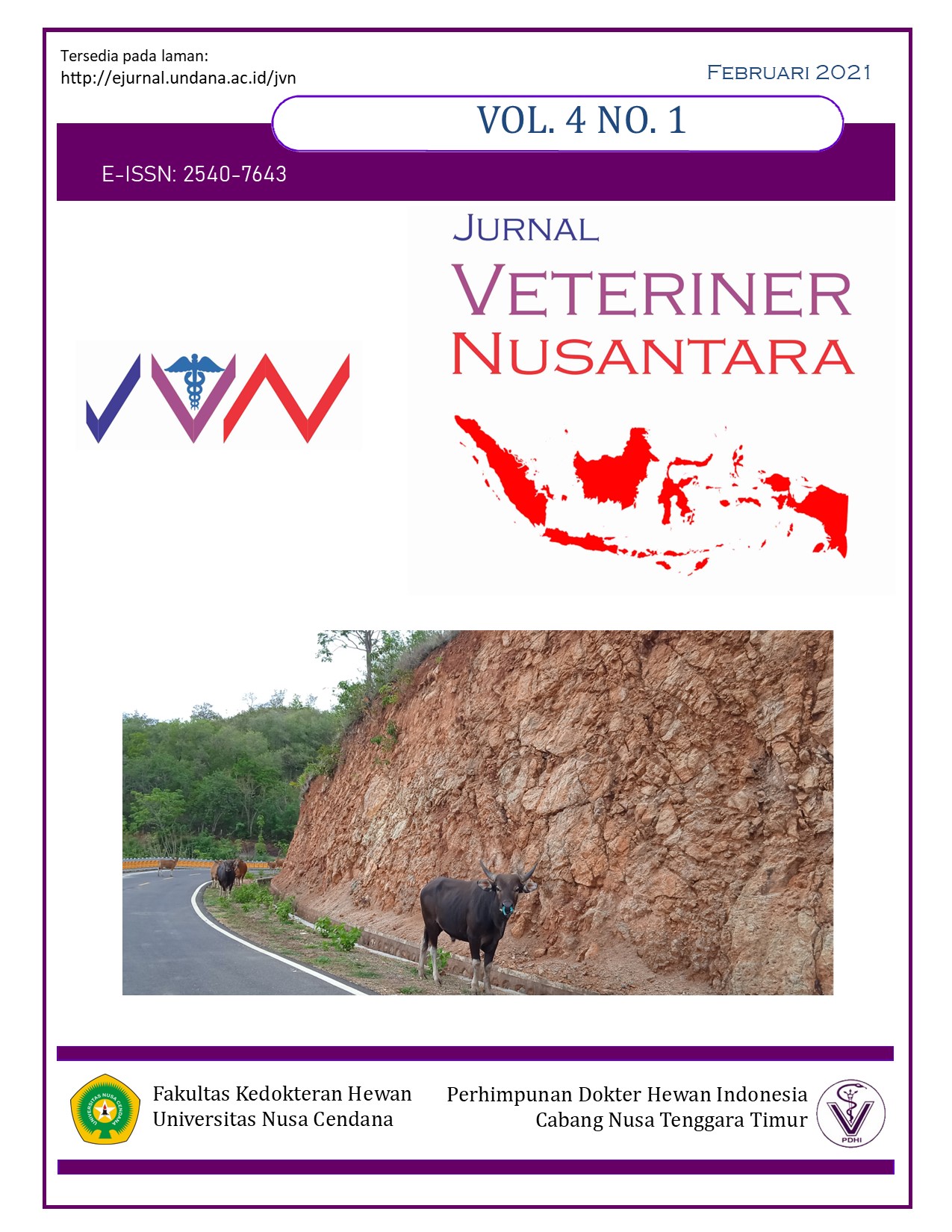Gambaran Siklus Hidup Nyamuk Aedes sp. Di Kota Kupang
Abstract
Aedes sp. is a type of mosquito that can carry dengue virus which causes dengue fever (DHF). DHF is an increasingly widespread public health problem with the increase in the mobility and population density. One effort that needs to be done in the control of DHF is to cut off the life cycle of mosquito Aedes sp. Therefore, it is necessary to have an understanding of the life cycle of mosquito Aedes sp. This study aims to determine the characteristics of morphology and life cycle of mosquito Aedes sp. in Kupang City. Study location in Kelurahan Oebobo and Kelurahan Kelapa Lima. The selection of this site is based on the highest incidence of DHF according to data from Kupang City Health Office in 2016. The study method includes Aedes sp. mosquito larvae collection, observation of the life cycle and identification of the development of mosquito Aedes sp. include measurement of temperature, humidity and pH of water. Sample of Aedes sp. mosquito larvae collected, then taken to the parasitology laboratory, Faculty of Veterinary Medicine, Nusa Cendana University. Observation of morphological characteristics of mosquito Aedes sp. done in macroscopically and microscopically. Next will observed the life cycle of mosquito Aedes sp. which is carried out at every stage of eggs, larvae, pupa, to adult using a stereo microsocpe and then matched with the identification key. The analytical data used is descriptive analysis shown in the form of table and drawing The results show that the life cycle of mosquito Aedes sp. in Kota Kupang ranging from 7-10 days with details of 1-2 egg stages, 3 days of larvae stage, L4 larvae to pupa 1-2 days and the pupa stage mature for 2-3 days, with an average temperature of 28,3ºC, humidity 60.4% and pH of water 7
Downloads
References
American Mosquito Control Association (AMCA), 2015, Life Cycle.Acessed 11 May 2015.
Anggraini, D.S. 2010, Stop Demam Berdarah Dengue, Cita Insan Madani. Bogor
Artha, E. 2011, Pengaruh Faktor Fisika, Kimia, Biologi Air Dengan Keberadaan Tumbuhan Enceng Gondok terhadap Perkembangbiakan Nyamuk Anopheles sp di Perairan Danau Toba Tahun 2010. Accessed 11 May 2015. Available from
Astuti, U.N.W, Cahyani R.W., dan Ardiansyah M, 2004. Pengaruh ekstrak etanol daun mindi (Melia azedarch L) terhadap daya tetas telur, perkembangan mortalitas larva Aedes aegypti L. Skripsi. Universitas Gajah Mada, Yogyakarta.
Azhari, 2004. Faktor Lingkungan yang Berpengaruh Terhadap Kejadian Infeksi Virus Dengue (Studi Kasus di Kota Semarang ). [online] Tesis. Program Pasca Sarjana. Universitas Diponogoro, Semarang. [diakses 10 Desember 2012] http://eprints.undip.ac.id/14484
Boesri, H. 2011, Biologi dan Peranan Aedes albopictus (Skuse) 1894 sebagai Penular Penyakit. Jurnal Aspirator, 3(2) 2011: 117-125
Cahyati, W.H. dan Suharyo. 2006, Dinamika Aedes Aegypti Sebagai Vektor Penyakit. Kemas, 2(1) Semarang.
CDC. 2012, Mosquito life-cycle. diakses tanggal 30 April 2013, < http://m_lifecycle.htm>
Christophers, S.R. 1960. Aedes aegypti (L.) The Yellow Fever Mosquito: It’s Life History, Bionomics, and Structure. Cambridge University Press. London.
Clements, A.N. 2000, The Biology of Mosquitoes Volume 1 Development, Nutrition, and Reproduction. USA : CABI Publishing.
Depkes. RI. 2003, Pencegahan dan Penanggulangan Penyakit Demam Dengue dan Demam Berdarah Dengue, Jakarta, Departemen Kesehatan Republik Indonesia.
Depkes RI. 2010, ‘Sudahkah Anda Mencegah Demam Berdarah’. Jakarta: Depkes RI. Diakses tanggal 11 Oktober 2012,
Departemen Kesehatan RI. 2004, Perilaku dan Siklus Hidup Nyamuk Aedes aegypti Sangat Penting Diketahui dalam Melakukan Kegiatan Pemberantasan Sarang Nyamuk termasuk Pemantauan Larva Secara Berkala dalam Buletin Harian Departemen Kesehatan, Jakarta, Departemen Kesehatan Republik Indonesia.
Departemen Kesehatan. 2005,Pencegahan dan Pemberantasan Demam Berdarah Dengue di Indonesia, Jakarta, Departemen Kesehatan Republik Indonesia.
Djakaria.2000,Vektor Penyakit Virus, Riketsia, Spiroketa Dan Bakteri.dalam: Srisasi, G. Dan Herry, D.I., Wita, P., penyunting. Parasitologi Kedokteran. Edisi Ketiga. Balai Penerbit FKUI, Jakarta: 235-237.
Embong, B.N. & Sudarmaja, I.M., 2016. Pengaruh Suhu Terhadap Angka Penetasan Telur Aedes aegypti. E-Jurnal Medika, 5(12), pp.1–8.
Epstein, P.R., Diaz, H.R., Elias, S., Grabherr, G., Graham, N.E., Martens, W.J.M.,Thomson, E.M. and Susskind, J. 1998, Biological and physical signs of climate change : focused on mosquito-borne diseases. Bul.Amer. Meterologic.Soc, 79: 409-17.
Flanningan, M.D., Stocks, B.J. and Wotton, B.M. 2000, Climate change and forest fires, Bull. Sci. Environ, 262: 221-229.
Ginanjar, G. 2008, Demam Berdarah: A Survival Guide. Cet. 1. B-First, PT. Bentang Pustaka, Yogyakarta.
Grissom, P., Alexander, M.E., Cella, B., Cole, F., Kurt, J.T., Malotte, N.P., Martell, D.L., Mawdsley, W., Roessler, J., Quilin, R. and Ward, P.C. 2000, Effects of climate change on management and policy: Mitigation option in the North American Boral Forest. Bull. Ecol. Stud, 138: 85-101.
Hadi, U.K dan Koesharto, F.X. 2006, dalam: Sigit, S.H.dan Hadi, U.K., 2006, Hama Permukiman Indonesia; Pengenalan, Biologi dan Pengendalian, UKPHP FKH IPB, Bogor, pp 23 – 51.
Hadi, U.K. dan Soviana, S. 2010. Ektoparasit Pengenalan, Identifikasi, dan pengendaliannya, IPB Press, Bogor.
Hidayat, M.C., Santoso, L. dan , Suwasono, H. 1997, Pengaruh pH Air Perindukan Terhadap Pertumbuhan dan Perkembangan Aedes Aegypti Pra Dewasa. Cermin Dunia Kedokteran. 119: 47-49
Hoedojo, 1993, Vektor Demam Berdarah Dengue Dan Penanggulangannya, Perhimpunan, Pemberantasan Penyakit Parasit Indonesia, Majalah Parasitologi Indonesia, Vol 6 Januari 1993, Jakarta.
Hopp and Foley. 2001. The Aedes aegypti Life Cycle. Assessing the Impact of Treatment of Septic Tanks with Expanded Polystyrene Beads on Aedes Aegypti Larval and Adult Mosquito. Stanford Pub, USA.
Iskandar, Adang, Sudjain, Sanropie, Jasio.,Nuidja, Maksun, Slamet, A.R, Martina, Sembiring, dan Firdaus. (1985), Pemberantasan Serangga dan Binatang Pengganggu. Pusdiknakes, Jakarta.
ICPMR, Department of Entomology. 2002, ‘Mosquito Photos’, NSW Arbovirus Surveillance & Vector Monitoring Program, viewed June 28, 2015,
Kemenkes RI. 2010, Buletin Jendela Epidemiologi Demam Berdarah Dengue. Pusat Data dan Surveilens Epidemiologi Kementrian Kesehatan RI, 2,1.
Kardinan, A. 2003, Tanaman Pengusirdan Pembasmi Nyamuk Vol I. Jakarta: Agro Media Pustaka, pp: 2-5, 22-23, 28-29.
Mardihusodo, S.J. 1988, Pengaruh Perubahan Lingkungan Fisik Terhadap Penetasan Telur Nyamuk Aedes Aegypti. Berita Kedokteran Masyarakat IV: 6
McCafferty, Patrick W. 2010, ‘Biological Notes on Mosquitoes’. viewed 7 Maret 2011,
Notoatmodjo, S. 2007, Promosi kesehatan dan ilmu perilaku, Rineka cipta, Jakarta.
Novitasari, I., dan Sugiyanto, Z. 2014, ‘Hubungan Suhu, Kelembapan Rumah Dan Perilaku Masyarakat Tentang PSN Dan Larvasidasi Dengan Keberadaan Jentik Nyamuk Penular Demam Berdarah Dengue di RW 01 Kelurahan Sendangguwo Semarang’, Prosiding Seminar Nasional & Call For Paper Teknologi dan Pengelolaan Informasi dalam Manajemen Bencana dan Surveilans Kesehatan, Semarang, pp. 17-25,
Rattanarithikul, R. and Harrison, B. 2005, Illustrated Keys to the Mosquitoes of Thailand I. Background; Geographic Distribution; Lists of Genera, Subgenera, dan Species; dan a Key to the Genera. The Southeast Asian Journal of Tropical Medicine, Volume 36 Supplement 1, 2005, Bangkok.
Rey, J.R. 2006, ‘The Mosquitoes’, viewed 8 September 2011,
Said, P.S. 2011, Survei Keberadaan Jentik Nyamuk Aedes sp Pada Sumur gali Gali Milik Warga Di Kelurahan Bulusan Kota Semarang (Studi Di Wilayah Kerja Puskesmas Rowosari Semarang), Jurnal Kemas, 1(2) :326-337.
Sembel, D.T. 2009, Entomologi Kedokteran. ANDI : Yogyakarta
Sinar Harapan. 2003,‘Demam Berdarah di Indonesia Terbesar Setelah Thailand’, diakses pada 23 Agustus 2010,
Soegijanto, S. 2006, Demam Berdarah Dengue. Edisi 2, Airlangga University Press.
Sudarto. 1972. Atlas Entomologi Kedokteran. Jakarta: EGC
Sudibyo, P.A. 2012, Kepadatan Populasi Larva Aedes Aegypti Pada Musim Hujan Di Kelurahan Petemon, Surabaya. Skripsi, Surabaya.
Sugito, R. 1989. Aspek Entomologi Demam Berdarah Dengue. Direktorat Jenderal PPM dan PLP Departemen Kesehatan. pp 47.
Suman, D.S., Shrivastava, A., Pant, S., dan Parashar, B., 2011, Differentiation of Aedes aegypti and Aedes albopictus (Diptera: Culicidae) with Egg Surface Morphology and Morphometrics Using Scanning Electron Microscopy. Arthropod Structure & Development Elsevier. Amsterdam.
Sunaryo, 2001. Bionomik Vektor Malaria di Kabupaten Banjarnegara. SLPV, Banjarnegara. Kes Malaria di Kabupaten Banjarnegara. SLPV, Banjarnegara.
Price, J.W.K.P., and Rich, P.M. 2001, Spatial Patterns Of NDVI Response to Precipitation and Temperature in Central Greats Plains., 20 (18): 3827-3844. Viewed 2 November 2010.
World Health Organization.1999, Guidelines for Treatment of Dengue Fever/Dengue Hemmorhagic Fever in Small Hospitals, Regional Office for South-East Asia, New Delhi,WHO.
World Health Organization.(2009), Dengue. In Guidlines for Diagnosis, Treatment, Prevention and Control, Geneva, WHO.
Yudhastuti, R. dan Vidiyani, A. 2005, Hubungan Kondisi Lingkungan, Kontainer, dan Perilaku Masyarakat dengan Keberadaan Jentik Nyamuk Aedes Aegypti di daerah Endemis Demam Berdarah Dengue Surabaya. Jurnal Kesehatan Lingkungan., Edisi Januari 2005. 1(2): 170-182.
Yotopranoto, S., Subekti, S., Rosmanida, dan Sulaiman, (1998), Dinamika Populasi Vektor pada Lokasi dengan Kasus Demam Berdarah Dengue yang Tinggi di Kotamadya Surabaya. Majalah Kedokteran Tropis Indonesia.9(1 -2).
Yulidar & Wilya V. 2015, Siklus Hidup Aedes Aegypti pada Skala Laboratorium, Jurnal Penelitian Kesehatan, 2(1):22-28.

 Yohanes N P Lema(1*)
Yohanes N P Lema(1*)



 Visit Our G Scholar Profile
Visit Our G Scholar Profile




